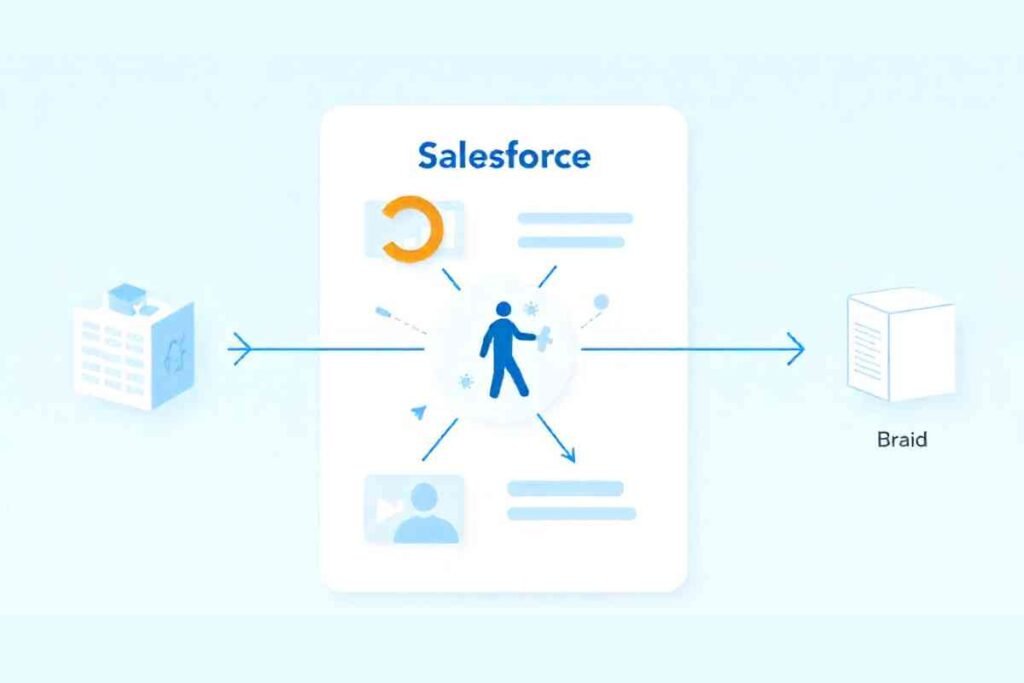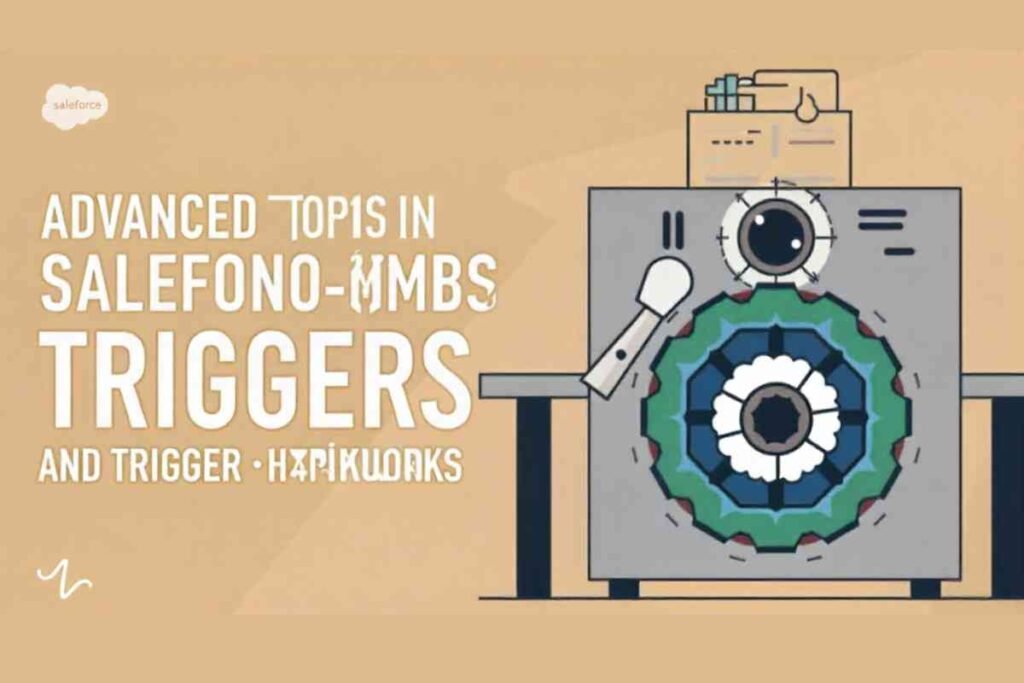Salesforce Trigger Interview Questions focus on the core logic automation concepts used in Salesforce development.
These questions test your understanding of trigger syntax execution order and real time business logic handling. Explore this guide to master every concept and confidently tackle any Salesforce trigger interview challenge.
Understanding Salesforce Triggers

Salesforce trigger interview questions are pieces of Apex code that execute before or after specific database events occur on records such as insert update delete or undelete.
Triggers allow developers to perform custom actions automatically when data changes happen in Salesforce. They operate at the database level offering powerful automation capabilities that go beyond what standard workflow rules or Process Builder can handle.
There are two main types of triggers before triggers and after triggers. A before trigger is used to validate or modify record values before they are saved to the database while an after trigger executes after the record has been committed often for actions like updating related records or sending notifications.
Understanding when to use each type is a common topic in Salesforce trigger interview questions because it demonstrates practical knowledge of trigger execution.
The Importance of Salesforce Triggers
Salesforce trigger interview questions help automate complex business processes and enforce consistency across data. For instance a trigger can be used to automatically calculate field values maintain audit trails or synchronize data between related objects.
In interviews candidates are often asked about the advantages of using triggers compared to declarative tools like flows or workflows.
A good answer includes understanding that triggers offer more control scalability and customization capabilities especially for large scale enterprise logic.
Types of Salesforce Triggers
There are two main types of Salesforce trigger interview questions before triggers and after triggers. Before triggers run prior to saving records to the database while after triggers execute after the data has been saved allowing you to access record IDs and perform related updates.
Before Triggers
Before triggers execute before records are saved to the database. They are commonly used for data validation setting default field values or modifying field data before the save operation.
When asked in interviews about before triggers you should emphasize that they help prevent bad data from being committed.
After Triggers
After triggers run once the record is successfully saved to the database. They are used when we need to access the record ID or perform operations that depend on committed data.
A common Salesforce trigger interview questions asks candidates to explain when to use an after trigger and to give examples such as updating parent records or creating audit entries.
Trigger Events in Salesforce
Triggers in Salesforce trigger interview questions can respond to specific DML events including before insert before update before delete after insert after update after delete and after undelete.
Each event has a specific purpose, and understanding how they work helps in writing efficient Apex code. For example a before insert trigger can modify a records data before it’s saved while an after delete trigger can perform cleanup or log deletion details.
During interviews explaining these events with real world examples strengthens your credibility as a Salesforce professional.
Common Salesforce Trigger Interview Questions
Common Salesforce trigger interview questions focus on understanding how triggers work their use cases, and best practices in automation. These questions test your ability to write efficient error free Apex triggers and handle complex business logic in Salesforce.
What are Salesforce triggers and why are they used?
This question tests your understanding of triggers as automation tools. You can explain that triggers allow custom logic execution in response to database changes providing advanced control over data manipulation and process automation.
What is the difference between before and after triggers?
In interviews this question highlights your conceptual clarity. A before trigger modifies or validates data before saving whereas an after trigger performs operations dependent on committed data such as updating child records or calling external systems.
What are Trigger.new and Trigger.old?
Trigger.new holds a list of new records in insert and update operations while Trigger.old contains the previous versions of records during update and delete operations. Knowing how to use these contexts effectively is a common theme in Salesforce trigger interview questions.
How do you prevent recursion in triggers?
Recursion happens when a trigger repeatedly invokes itself often causing system limits to be exceeded. To prevent this developers use static variables or boolean flags to ensure the trigger runs only once per transaction.
What are governor limits and how do they impact triggers?
Salesforce trigger interview questions imposes limits on database operations to ensure fair resource usage. Explaining how to write bulkified triggers that handle multiple records efficiently within governor limits is crucial for interview success.
Trigger Context Variables
Salesforce trigger interview questions provides several built in context variables that help developers understand the triggers state and context. Examples include Trigger.isBefore Trigger.isAfter Trigger.isInsert Trigger.isUpdate Trigger.isDelete and Trigger.isExecuting.
Mastery of these variables is essential for writing flexible and reusable code. Interviewers often ask candidates to describe how these variables control logic flow and how they can be combined in practical scenarios.
Writing Bulkified Triggers
Bulkification ensures that triggers can handle multiple records efficiently. A common Salesforce trigger interview question asks why bulkification is necessary.
The answer involves understanding that Salesforce processes up to 200 records per transaction and non bulkified code may exceed limits.
Using collections like Lists Sets and Maps is a recommended approach to handle bulk operations in a single transaction preventing performance issues and governor limit exceptions.
Trigger Design Patterns
One of the most advanced topics in Salesforce trigger interview questions is the use of trigger frameworks or design patterns.
These patterns help organize logic efficiently, making triggers easier to maintain and test. The most widely used pattern is the One Trigger per Object approach which separates business logic into handler classes.
This structure prevents redundancy and promotes reusability. In interviews explaining how a Trigger Handler class works along with examples demonstrates strong coding discipline and best practices.
Trigger Best Practices
A strong candidate not only understands how triggers work but also follows best practices. Avoid using multiple triggers on the same object always bulkify your code handle recursion properly and test thoroughly.
Ensure that triggers perform minimal logic delegating complex operations to Apex classes. Understanding these best practices is often tested in scenario based Salesforce trigger interview questions where the interviewer asks you to identify issues in sample code.
Testing Triggers
Testing is a vital part of Salesforce development. Unit tests validate that triggers perform as expected. In interviews candidates may be asked how to write efficient test classes for triggers.
The correct approach involves inserting and updating records in test methods to verify trigger outcomes. Test coverage should exceed 75% focusing not just on coverage but also on logic validation and exception handling.
Real World Use Cases
Interviewers often assess your practical understanding by asking scenario based questions like How would you ensure that when an Opportunity closes a related custom object updates automatically?
Such questions test your ability to translate business requirements into trigger logic. The ability to explain these real world examples confidently shows that you can apply theoretical knowledge in real projects.
Common Mistakes in Salesforce Triggers
Mistakes such as writing non bulkified code performing DML operations inside loops or neglecting recursion prevention are frequently discussed in Salesforce trigger interview questions. Interviewers expect you to not only identify these errors but also propose solutions.
Understanding the impact of these mistakes on performance and governor limits sets you apart as a competent developer.
Difference Between Triggers and Process Builder
Another frequently asked interview question involves comparing triggers with declarative automation tools like Process Builder or Flow.
While Process Builder is easier to use for simple automation, triggers provide more control and flexibility. They can handle complex logic bulk data and cross object interactions that Process Builder cannot manage efficiently.
Advanced Topics in Salesforce Triggers

Advanced topics in Salesforce Triggers explore complex concepts like recursion control bulkification and trigger frameworks. These help developers write cleaner more efficient and scalable code for real world business automation.
Order of Execution
Explaining Salesforces order of execution demonstrates deep technical knowledge. It defines how workflows validations and triggers interact during a record transaction.
Asynchronous Triggers
Interviewers sometimes explore your knowledge of handling asynchronous operations like Queueable Apex or Future methods within triggers to optimize performance and reduce execution time.
Error Handling
Knowing how to implement proper exception handling in triggers ensures data integrity and system reliability. Candidates should explain how try catch blocks and custom exceptions can be used to manage errors gracefully.
How to Prepare for Salesforce Trigger Interview Questions?
To prepare effectively focus on understanding trigger syntax logic structuring, context variables and design patterns. Practice writing triggers for various scenarios review governor limits, and study test class implementation.
Reading Salesforce trigger interview questions documentation and solving real world problems will help you develop the confidence needed to handle any interview question with ease.
Boost your Salesforce career today master Apex triggers practice real world scenarios and ace your next Salesforce trigger interview with confidence!
You can explore the articles below and get more helpful information directly from our website.
History Class 10 ICSE Solutions
Conclusion
Mastering Salesforce Trigger Interview Questions is all about understanding how Apex triggers work their execution order and how they handle complex business logic.
By learning the difference between before and after triggers bulkifying your code and following best practices you can write efficient and scalable automation. A strong grasp of trigger context variables frameworks and real world use cases will help you stand out in any interview.
Keep practicing with different trigger scenarios review Salesforce documentation regularly and focus on clean optimized coding to become a confident and capable Salesforce developer.
FAQs
What are Salesforce triggers used for?
Salesforce triggers are used to automate actions before or after database events such as insert, update, delete, or undelete. They help enforce business logic and ensure data consistency automatically.
What is the difference between before and after triggers?
Before triggers run before saving data to the database to validate or modify records, while after triggers execute post-save to perform operations like updating related records or sending notifications.
How do you prevent recursion in Salesforce triggers?
Recursion can be prevented by using static boolean variables or flags in Apex classes. These ensure that the trigger logic runs only once per transaction, avoiding infinite loops.
What are Trigger.new and Trigger.old in Salesforce?
Trigger.new contains new versions of records for insert and update events, while Trigger.old holds the previous versions during update or delete events. They help developers compare data changes efficiently.
Why is bulkification important in Salesforce triggers?
Bulkification ensures triggers can handle multiple records in a single transaction. It prevents hitting governor limits by using collections like Lists, Sets, and Maps for efficient data processing.
What are common mistakes developers make in triggers?
Common mistakes include using DML operations inside loops, not handling recursion, and writing non-bulkified code. These lead to performance issues and may exceed Salesforce governor limits.
How do you test triggers effectively in Salesforce?
Effective trigger testing involves creating unit tests that insert, update, and delete records to verify logic behavior. Test coverage should exceed 75% and include positive and negative scenarios.
What is the best practice for writing Salesforce triggers?
Follow the “One Trigger per Object” rule, delegate logic to handler classes, and keep triggers bulkified and recursion-safe. This ensures cleaner, maintainable, and scalable Salesforce code.